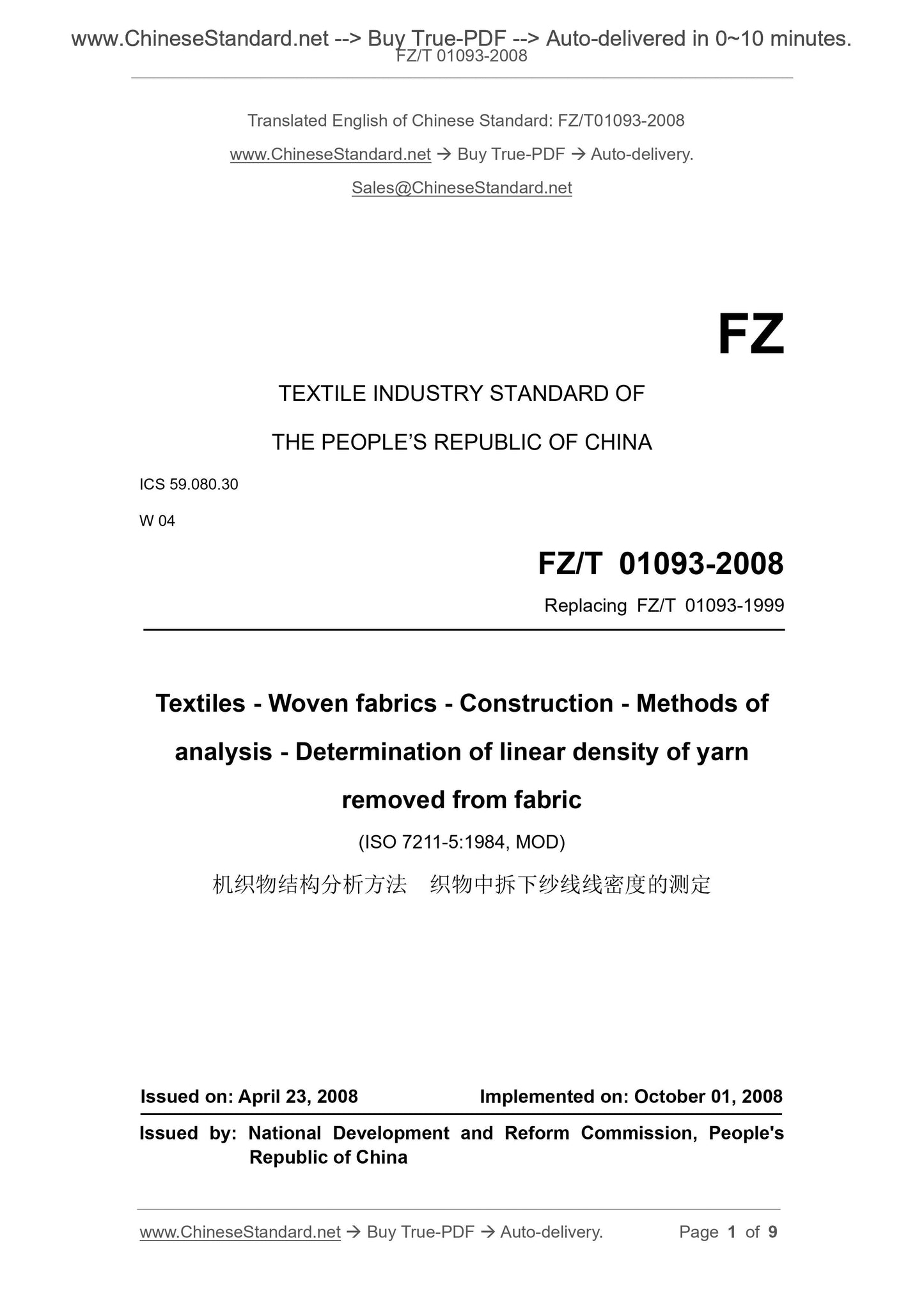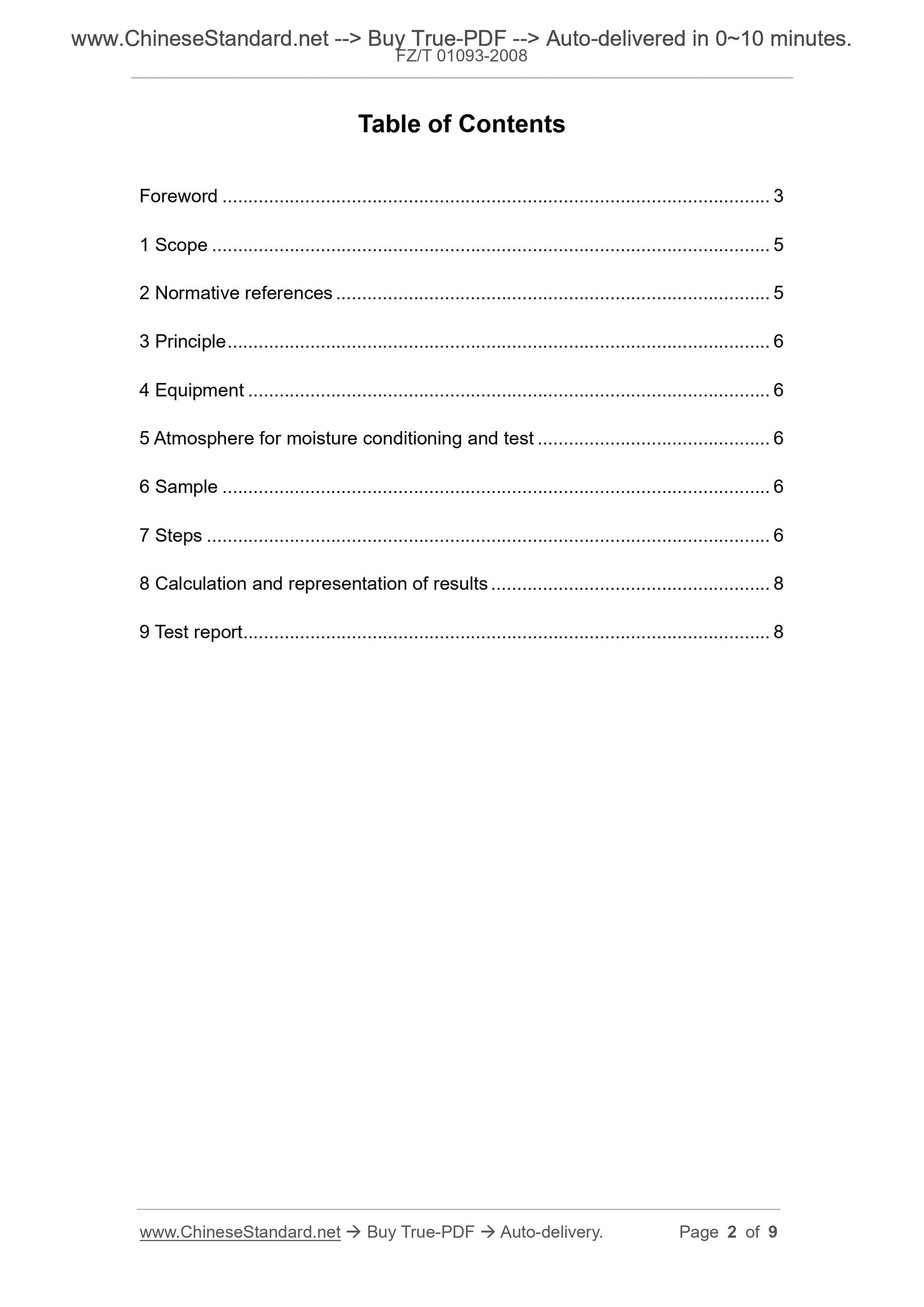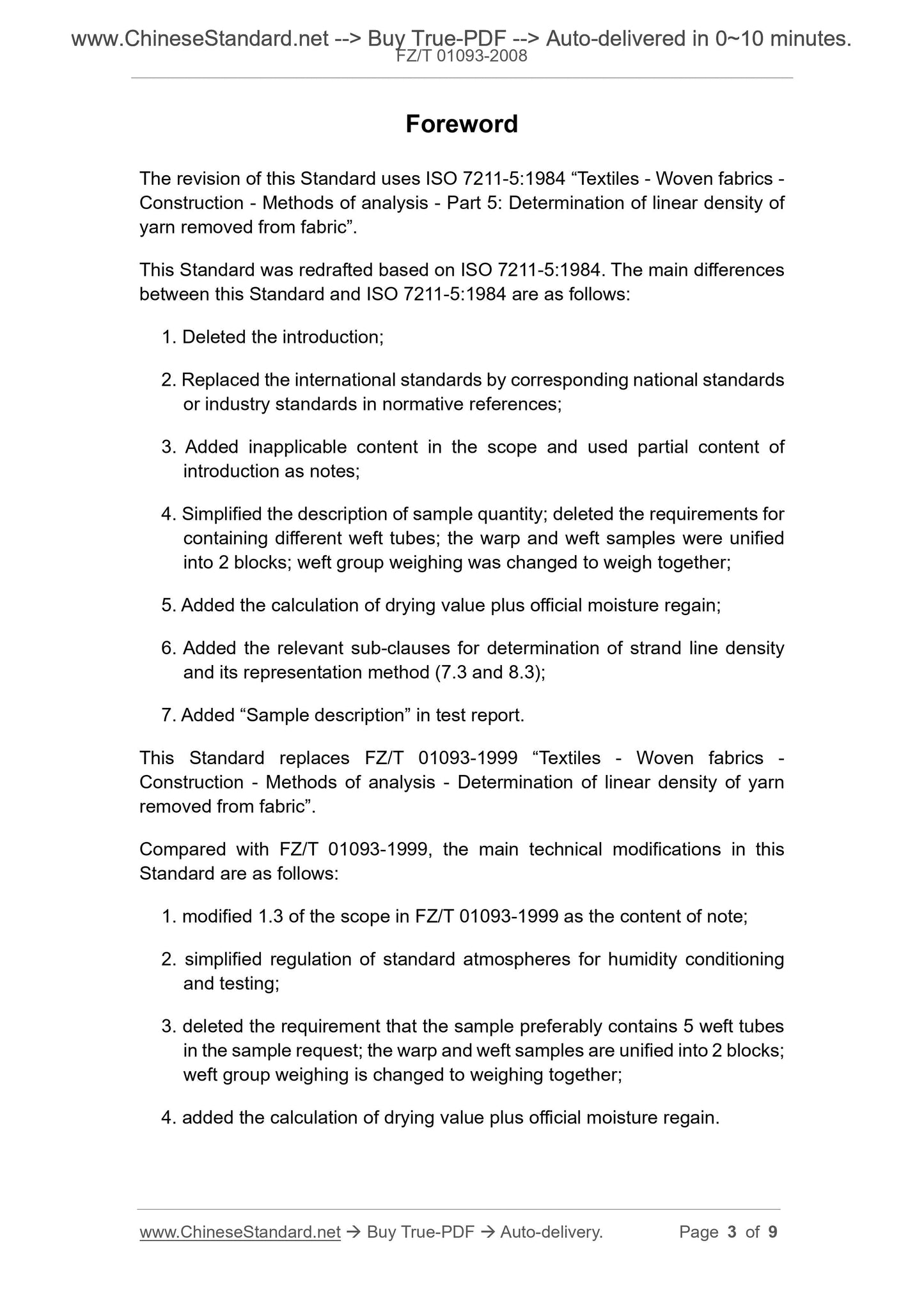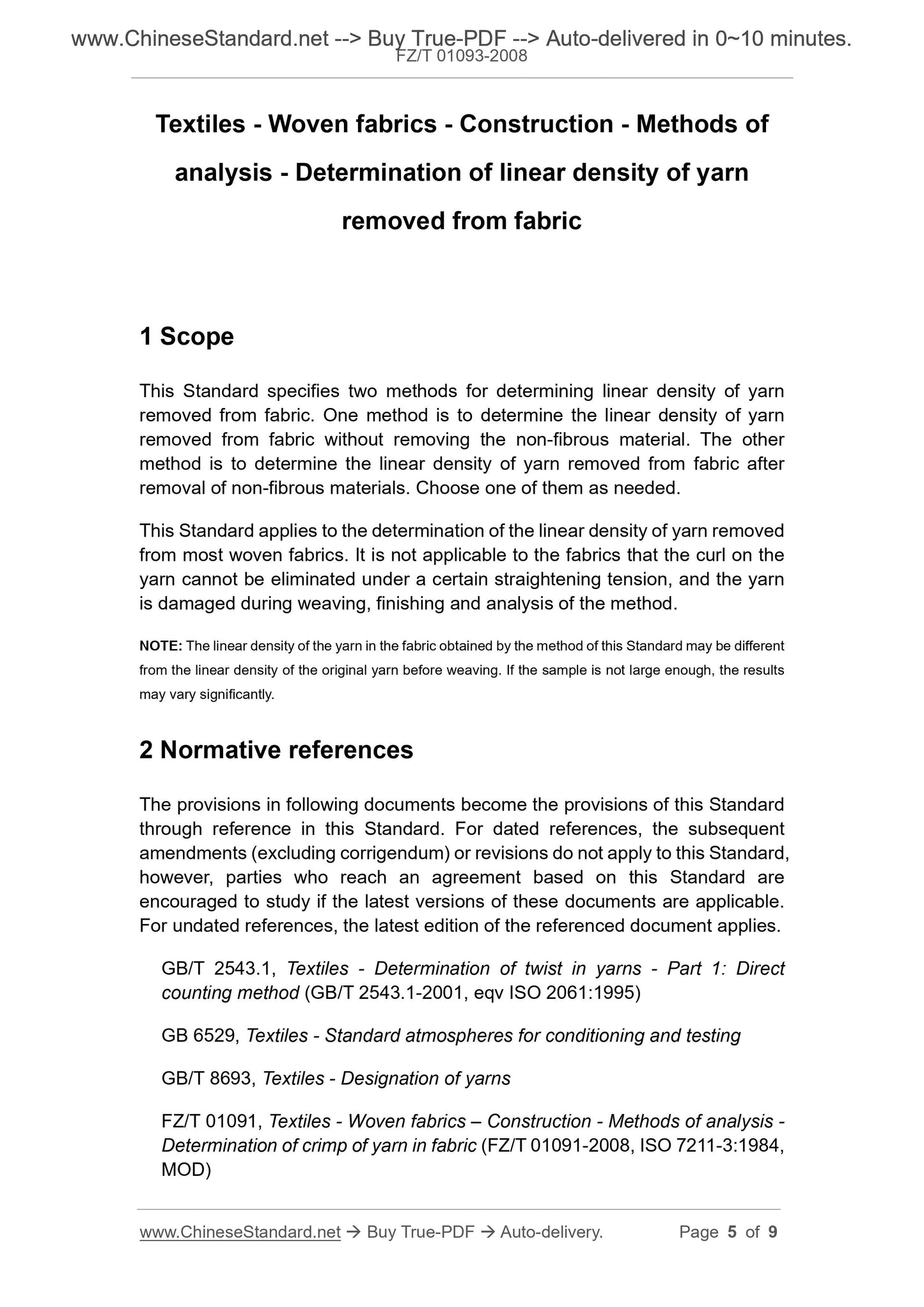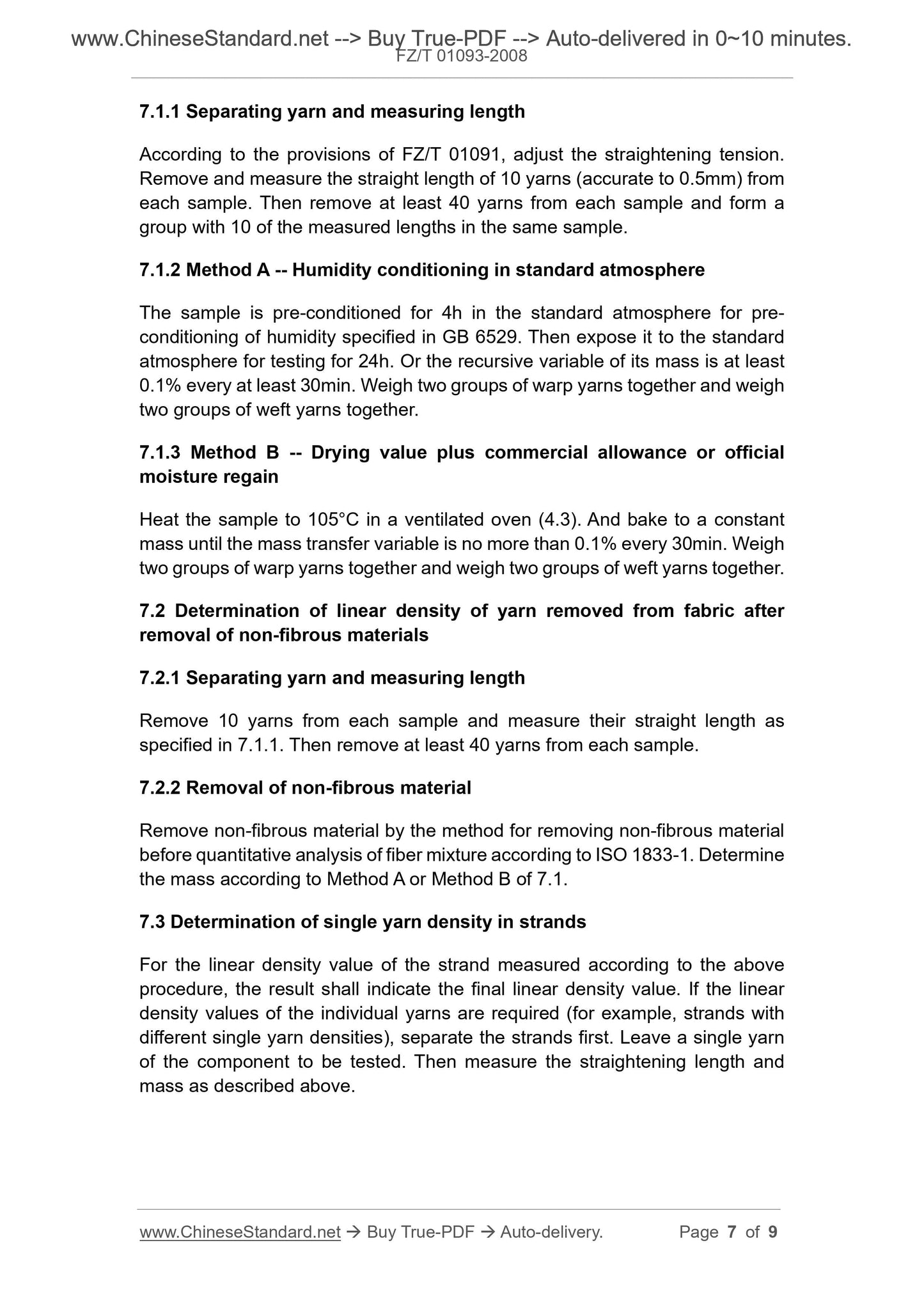1
/
의
5
PayPal, credit cards. Download editable-PDF and invoice in 1 second!
FZ/T 01093-2008 English PDF (FZT01093-2008)
FZ/T 01093-2008 English PDF (FZT01093-2008)
정가
$90.00 USD
정가
할인가
$90.00 USD
단가
/
단위
배송료는 결제 시 계산됩니다.
픽업 사용 가능 여부를 로드할 수 없습니다.
Delivery: 3 seconds. Download true-PDF + Invoice.
Get QUOTATION in 1-minute: Click FZ/T 01093-2008
Historical versions: FZ/T 01093-2008
Preview True-PDF (Reload/Scroll if blank)
FZ/T 01093-2008: Textiles. Woven fabrics. Construction. Methods of analysis. Determination of linear density of yarn removed from fabric
FZ/T 01093-2008
TEXTILE INDUSTRY STANDARD OF
THE PEOPLE’S REPUBLIC OF CHINA
ICS 59.080.30
W 04
Replacing FZ/T 01093-1999
Textiles - Woven fabrics - Construction - Methods of
analysis - Determination of linear density of yarn
removed from fabric
(ISO 7211-5:1984, MOD)
ISSUED ON: APRIL 23, 2008
IMPLEMENTED ON: OCTOBER 01, 2008
Issued by: National Development and Reform Commission, People's
Republic of China
Table of Contents
Foreword ... 3
1 Scope ... 5
2 Normative references ... 5
3 Principle ... 6
4 Equipment ... 6
5 Atmosphere for moisture conditioning and test ... 6
6 Sample ... 6
7 Steps ... 6
8 Calculation and representation of results ... 8
9 Test report ... 8
Foreword
The revision of this Standard uses ISO 7211-5:1984 “Textiles - Woven fabrics -
Construction - Methods of analysis - Part 5: Determination of linear density of
yarn removed from fabric”.
This Standard was redrafted based on ISO 7211-5:1984. The main differences
between this Standard and ISO 7211-5:1984 are as follows:
1. Deleted the introduction;
2. Replaced the international standards by corresponding national standards
or industry standards in normative references;
3. Added inapplicable content in the scope and used partial content of
introduction as notes;
4. Simplified the description of sample quantity; deleted the requirements for
containing different weft tubes; the warp and weft samples were unified
into 2 blocks; weft group weighing was changed to weigh together;
5. Added the calculation of drying value plus official moisture regain;
6. Added the relevant sub-clauses for determination of strand line density
and its representation method (7.3 and 8.3);
7. Added “Sample description” in test report.
This Standard replaces FZ/T 01093-1999 “Textiles - Woven fabrics -
Construction - Methods of analysis - Determination of linear density of yarn
removed from fabric”.
Compared with FZ/T 01093-1999, the main technical modifications in this
Standard are as follows:
1. modified 1.3 of the scope in FZ/T 01093-1999 as the content of note;
2. simplified regulation of standard atmospheres for humidity conditioning
and testing;
3. deleted the requirement that the sample preferably contains 5 weft tubes
in the sample request; the warp and weft samples are unified into 2 blocks;
weft group weighing is changed to weighing together;
4. added the calculation of drying value plus official moisture regain.
Textiles - Woven fabrics - Construction - Methods of
analysis - Determination of linear density of yarn
removed from fabric
1 Scope
This Standard specifies two methods for determining linear density of yarn
removed from fabric. One method is to determine the linear density of yarn
removed from fabric without removing the non-fibrous material. The other
method is to determine the linear density of yarn removed from fabric after
removal of non-fibrous materials. Choose one of them as needed.
This Standard applies to the determination of the linear density of yarn removed
from most woven fabrics. It is not applicable to the fabrics that the curl on the
yarn cannot be eliminated under a certain straightening tension, and the yarn
is damaged during weaving, finishing and analysis of the method.
NOTE: The linear density of the yarn in the fabric obtained by the method of this Standard may be different
from the linear density of the original yarn before weaving. If the sample is not large enough, the results
may vary significantly.
2 Normative references
The provisions in following documents become the provisions of this Standard
through reference in this Standard. For dated references, the subsequent
amendments (excluding corrigendum) or revisions do not apply to this Standard,
however, parties who reach an agreement based on this Standard are
encouraged to study if the latest versions of these documents are applicable.
For undated references, the latest edition of the referenced document applies.
GB/T 2543.1, Textiles - Determination of twist in yarns - Part 1: Direct
counting method (GB/T 2543.1-2001, eqv ISO 2061:1995)
GB 6529, Textiles - Standard atmospheres for conditioning and testing
GB/T 8693, Textiles - Designation of yarns
FZ/T 01091, Textiles - Woven fabrics – Construction - Methods of analysis -
Determination of crimp of yarn in fabric (FZ/T 01091-2008, ISO 7211-3:1984,
MOD)
7.1.1 Separating yarn and measuring length
According to the provisions of FZ/T 01091, adjust the straightening tension.
Remove and measure the straight length of 10 yarns (accurate to 0.5mm) from
each sample. Then remove at least 40 yarns from each sample and form a
group with 10 of the measured lengths in the same sample.
7.1.2 Method A -- Humidity conditioning in standard atmosphere
The sample is pre-conditioned for 4h in the standard atmosphere for pre-
conditioning of humidity specified in GB 6529. Then expose it to the standard
atmosphere for testing for 24h. Or the recursive variable of its mass is at least
0.1% every at least 30min. Weigh two groups of warp yarns together and weigh
two groups of weft yarns together.
7.1.3 Method B -- Drying value plus commercial allowance or official
moisture regain
Heat the sample to 105°C in a ventilated oven (4.3). And bake to a constant
mass until the mass transfer variable is no more than 0.1% every 30min. Weigh
two groups of warp yarns together and weigh two groups of weft yarns together.
7.2 Determination of linear density of yarn removed from fabric after
removal of non-fibrous materials
7.2.1 Separating yarn and measuring length
Remove 10 yarns from each sample and measure their straight length as
specified in 7.1.1. Then remove at least 40 yarns from each sample.
7.2.2 Removal of non-fibrous material
Remove non-fibrous material by the method for removing non-fibrous material
before quantitative analysis of fiber mixture according to ISO 1833-1. Determine
the mass according to Method A or Method B of 7.1.
7.3 Determination of single yarn density in strands
For the linear density value of the strand measured according to the above
procedure, the result shall indicate the final linear density value. If the linear
density values of the individual yarns are required (for example, strands with
different single yarn densities), separate the strands first. Leave a single yarn
of the component to be tested. Then measure the straightening length and
mass as described above.
Get QUOTATION in 1-minute: Click FZ/T 01093-2008
Historical versions: FZ/T 01093-2008
Preview True-PDF (Reload/Scroll if blank)
FZ/T 01093-2008: Textiles. Woven fabrics. Construction. Methods of analysis. Determination of linear density of yarn removed from fabric
FZ/T 01093-2008
TEXTILE INDUSTRY STANDARD OF
THE PEOPLE’S REPUBLIC OF CHINA
ICS 59.080.30
W 04
Replacing FZ/T 01093-1999
Textiles - Woven fabrics - Construction - Methods of
analysis - Determination of linear density of yarn
removed from fabric
(ISO 7211-5:1984, MOD)
ISSUED ON: APRIL 23, 2008
IMPLEMENTED ON: OCTOBER 01, 2008
Issued by: National Development and Reform Commission, People's
Republic of China
Table of Contents
Foreword ... 3
1 Scope ... 5
2 Normative references ... 5
3 Principle ... 6
4 Equipment ... 6
5 Atmosphere for moisture conditioning and test ... 6
6 Sample ... 6
7 Steps ... 6
8 Calculation and representation of results ... 8
9 Test report ... 8
Foreword
The revision of this Standard uses ISO 7211-5:1984 “Textiles - Woven fabrics -
Construction - Methods of analysis - Part 5: Determination of linear density of
yarn removed from fabric”.
This Standard was redrafted based on ISO 7211-5:1984. The main differences
between this Standard and ISO 7211-5:1984 are as follows:
1. Deleted the introduction;
2. Replaced the international standards by corresponding national standards
or industry standards in normative references;
3. Added inapplicable content in the scope and used partial content of
introduction as notes;
4. Simplified the description of sample quantity; deleted the requirements for
containing different weft tubes; the warp and weft samples were unified
into 2 blocks; weft group weighing was changed to weigh together;
5. Added the calculation of drying value plus official moisture regain;
6. Added the relevant sub-clauses for determination of strand line density
and its representation method (7.3 and 8.3);
7. Added “Sample description” in test report.
This Standard replaces FZ/T 01093-1999 “Textiles - Woven fabrics -
Construction - Methods of analysis - Determination of linear density of yarn
removed from fabric”.
Compared with FZ/T 01093-1999, the main technical modifications in this
Standard are as follows:
1. modified 1.3 of the scope in FZ/T 01093-1999 as the content of note;
2. simplified regulation of standard atmospheres for humidity conditioning
and testing;
3. deleted the requirement that the sample preferably contains 5 weft tubes
in the sample request; the warp and weft samples are unified into 2 blocks;
weft group weighing is changed to weighing together;
4. added the calculation of drying value plus official moisture regain.
Textiles - Woven fabrics - Construction - Methods of
analysis - Determination of linear density of yarn
removed from fabric
1 Scope
This Standard specifies two methods for determining linear density of yarn
removed from fabric. One method is to determine the linear density of yarn
removed from fabric without removing the non-fibrous material. The other
method is to determine the linear density of yarn removed from fabric after
removal of non-fibrous materials. Choose one of them as needed.
This Standard applies to the determination of the linear density of yarn removed
from most woven fabrics. It is not applicable to the fabrics that the curl on the
yarn cannot be eliminated under a certain straightening tension, and the yarn
is damaged during weaving, finishing and analysis of the method.
NOTE: The linear density of the yarn in the fabric obtained by the method of this Standard may be different
from the linear density of the original yarn before weaving. If the sample is not large enough, the results
may vary significantly.
2 Normative references
The provisions in following documents become the provisions of this Standard
through reference in this Standard. For dated references, the subsequent
amendments (excluding corrigendum) or revisions do not apply to this Standard,
however, parties who reach an agreement based on this Standard are
encouraged to study if the latest versions of these documents are applicable.
For undated references, the latest edition of the referenced document applies.
GB/T 2543.1, Textiles - Determination of twist in yarns - Part 1: Direct
counting method (GB/T 2543.1-2001, eqv ISO 2061:1995)
GB 6529, Textiles - Standard atmospheres for conditioning and testing
GB/T 8693, Textiles - Designation of yarns
FZ/T 01091, Textiles - Woven fabrics – Construction - Methods of analysis -
Determination of crimp of yarn in fabric (FZ/T 01091-2008, ISO 7211-3:1984,
MOD)
7.1.1 Separating yarn and measuring length
According to the provisions of FZ/T 01091, adjust the straightening tension.
Remove and measure the straight length of 10 yarns (accurate to 0.5mm) from
each sample. Then remove at least 40 yarns from each sample and form a
group with 10 of the measured lengths in the same sample.
7.1.2 Method A -- Humidity conditioning in standard atmosphere
The sample is pre-conditioned for 4h in the standard atmosphere for pre-
conditioning of humidity specified in GB 6529. Then expose it to the standard
atmosphere for testing for 24h. Or the recursive variable of its mass is at least
0.1% every at least 30min. Weigh two groups of warp yarns together and weigh
two groups of weft yarns together.
7.1.3 Method B -- Drying value plus commercial allowance or official
moisture regain
Heat the sample to 105°C in a ventilated oven (4.3). And bake to a constant
mass until the mass transfer variable is no more than 0.1% every 30min. Weigh
two groups of warp yarns together and weigh two groups of weft yarns together.
7.2 Determination of linear density of yarn removed from fabric after
removal of non-fibrous materials
7.2.1 Separating yarn and measuring length
Remove 10 yarns from each sample and measure their straight length as
specified in 7.1.1. Then remove at least 40 yarns from each sample.
7.2.2 Removal of non-fibrous material
Remove non-fibrous material by the method for removing non-fibrous material
before quantitative analysis of fiber mixture according to ISO 1833-1. Determine
the mass according to Method A or Method B of 7.1.
7.3 Determination of single yarn density in strands
For the linear density value of the strand measured according to the above
procedure, the result shall indicate the final linear density value. If the linear
density values of the individual yarns are required (for example, strands with
different single yarn densities), separate the strands first. Leave a single yarn
of the component to be tested. Then measure the straightening length and
mass as described above.
Share
